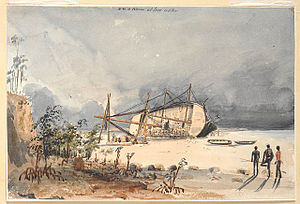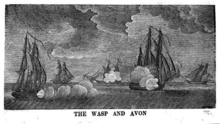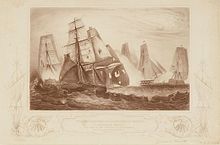- Cruizer class brig-sloop
-
For other Cruizer class ships, see Cruizer class.

The Cruizer-class brig-sloop HMS Pelorus aground at low waterClass overview Name: Cruizer-class brig sloop Operators:  Royal Navy
Royal NavyIn service: 1797–1826 Completed: 110 General characteristics Type: Brig-sloop Tons burthen: 384 bm[1] Length: 100.5 ft (30.6 m) Beam: 30.5 ft (9.3 m) Sail plan: Brig Complement: 121 Armament: 18 cannon
- 2 x 6-pounder bow guns
- 16 x 32-pounder carronades
The Cruizer class was an 18-gun class of brig-sloops of the Royal Navy. Brig-sloops were the same as ship-sloops except for their rigging. A ship-sloop was rigged with three masts whereas a brig-sloop was rigged as a brig with two masts — a fore mast and a main mast.
The Cruizer class was the most numerous class of warships built by the British during the Napoleonic wars, with 110 vessels built to this design, and the second most numerous class of sailing warship built to a single design for any navy at any time, after the smaller 10-gun Cherokee-class brig-sloops.[2]
Of the vessels in the class, eight (8%) were lost to the enemy, either destroyed or taken. Another was taken, but retaken. Fourteen (13%) were wrecked while in British service. Lastly, four (4%) foundered while in British service. In all cases of foundering and in many cases of wrecking all the crew was lost. Many of the vessels in the class were sold, some into mercantile service. One at least was wrecked. The fate of the others is generally unknown.
Contents
Design
In December 1796, the Navy Board placed new orders for four flush-decked sloops, to differing designs by the two Surveyors of the Navy — Sir William Rule and Sir John Henslow. In order to compare the qualities of ship-rigged and brig-rigged vessels, one vessel to each design was to be completed as a ship-sloop and the other as a brig-sloop. While the Henslow-designed vessels (the brig-sloop edit] Service in the War of 1812
During the Anglo-American War of 1812, several of the class fell victim to larger American sloops of war of nominally the same class. The American vessels generally enjoyed a slight advantage in weight of broadside and number of crew[citation needed]. The ship rigged sloops enjoyed the ability to back sail and the rigging proved far more resistant to damage whereas a single hit to the brig sloop's rig could render it unmanageable. In many cases, however, the advantage was in the quality of crew[citation needed], as the American sloops generally had hand-picked volunteer crews, while the brigs belonging to the overstretched Royal Navy had to make do with crews filled out with landsmen picked up by the press gang[citation needed].
Ships
The following table lists the Cruizer-class brig-sloops by the date on which the Admiralty ordered them.
 External images
External images
Model of HMS Cruizer 
Another model of HMS Cruizer HMS Pelorus ca. 1830, after conversion to a three-masted ship-sloop.

 Sketch of a brig-sloop, probably HMS Clio, by Cmdr. William Farrington, ca. 1812, Peabody Essex Museum
Sketch of a brig-sloop, probably HMS Clio, by Cmdr. William Farrington, ca. 1812, Peabody Essex Museum
 HMS Surinam struck by lightning, 11 December 1806, by Nicholas Matthews Condy, National Maritime Museum, Greenwich
HMS Surinam struck by lightning, 11 December 1806, by Nicholas Matthews Condy, National Maritime Museum, Greenwich
Name Ordered Builder Launched Fate Cruizer 19 December 1796 Stephen Teague, Ipswich 20 December 1797 Broken up February 1819 unnamed 15 March 1797 Thomas Pitcher, Northfleet never commenced order subsequently cancelled St Vincent's Board
The Board ordered 19 in 1802 and 1803.
Name Ordered Builder Launched Fate Scorpion 27 November 1802 John King, Dover 17 October 1803 Sold 1819 Dispatch 27 November 1802 Richard Symons, Falmouth 26 May 1804 Broken up 1811 Scout 27 November 1802 Peter Atkinson, Hull 7 August 1804 Sold 1827 Musquito 27 November 1802 John Preston, Great Yarmouth 4 September 1804 Sold 1822 Dartmouth 24 December 1805 Broken up 1815 Ferret 27 November 1802 Benjamin Tanner, Dartmouth 4 January 1806 Abandoned as a wreck 1813 Leveret 16 July 1803 John King, Dover 14 January 1806 Wrecked 1807 Belette 16 July 1803 John King, Dover 21 March 1806 Wrecked 1812 Amaranthe 15 October 1803 John Dudman, Deptford Wharf 20 November 1804 Sold 1815 Calypso 15 October 1803 John Dudman, Deptford Wharf 2 February 1805 Broken up 1821 Dover 22 September 1804 Broken up 1821 Surinam 7 November 1803 Obadiah Ayles, Topsham January 1805 Sold for breaking up 1825 Wolverine 7 November 1803 Thomas Owen, Topsham 1 March 1805 Sold 1816 Dover October 1804 Sold 1815 Weazle 7 November 1803 Thomas Owen, Topsham 2 March 1805 Sold 1815 King's Lynn 14 June 1805 Broken up 1814 Racehorse 7 November 1803 Hamilton & Breeds, Hastings 17 February 1806 Wrecked 1822 Avon 9 December 1803 Richard Symons & Co., Falmouth 31 January 1805 Foundered as a result of damage in fight with U.S. 22-gun sloop-of-war Wasp 1814 edit] Melville's First Board The Board ordered ordered six vessels to this design during May 1804, all of fir. Building of fir (pine) made for speedier construction at the cost of reduced durability in service.
Name Ordered Builder Launched Fate Beagle 22 May 1804 Perry, Wells & Green, Blackwall Yard 8 August 1804 Sold 1814 Elk 22 May 1804 Frances Barnard, Sons & Co., Deptford Dockyard 22 August 1804 Broken up 1812 Raven 23 May 1804 Perry, Wells & Green, Blackwall Yard 25 July 1804 Wrecked 1805 Saracen 23 May 1804 Perry, Wells & Green, Blackwall Yard 25 July 1804 Broken up 1812 Reindeer 23 May 1804 Samuel & Daniel Brent, Rotherhithe 15 August 1804 Taken by USS Wasp and burnt 1814 Harrier 23 May 1804 Frances Barnard, Sons & Co., Deptford Dockyard 22 August 1804 Believed to have foundered near Rodrigues Island in the Indian Ocean in March 1809[3] Barham's Board
The Board ordered 22 vessels to this design, seventeen of which were launched in 1806 and five in 1807.
Name Ordered Builder Launched Fate Forester 16 July 1805 John King, Dover 3 August 1806 Sold 1819 Foxhound 16 July 1805 John King, Dover 30 November 1806 Foundered 1809 Mutine 22 July 1805 Henry Tucker, Bideford 15 August 1806 Sold 1819 Emulous 21 August 1805 William Row, Newcastle June 1806 Wrecked 1812; crew saved but Emulous was unsalvageable.[4] Texel and surrendered to the Batavian Republic on 25 December 1811, with no loss of life among her crew,[5] though the pilot was killed.[6] She became the Dutch brig Irene; broken up at Flushing in 1822. Sapientza Island, Greece; Captain and master were reprimanded for having only one anchor down.[7] Scaw Reef off the coast of Jutland. The ship's boats were frozen to the deck so it was only the next day that the Danes were able to rescue most of the crew; 29 of her crew of 121 died and the rest became prisoners.[8] Alacrity 14 January 1806 William Row, Newcastle 13 November 1806 Taken by French brig Abeille 1811; in French Navy as Alacrity until broken up in 1822. Brightlingsea 30 August 1806 Foundered 1827 after leaving Sierra Leone; wreckage washed ashore in November near Mataceney suggested that lightning had started a fire that destroyed her.[9] Ringdove 27 January 1806 Matthew Warren, Brightlingsea 16 October 1806 Sold 1829 Taken and sunk by U.S. brig Hornet 1813. Peacock sank with four of her crew and three Americans aboard.[10] Sappho 27 January 1806 Jabez Bailey, Ipswich 15 December 1806 Broken up 1830 Recruit 27 January 1806 Thomas Hills, Sandwich 31 August 1806 Sold 1822 Bideford 3 October 1807 Taken by French brig Palinure 1808 and burnt 1809 Clio 29 January 1806 James Betts, Mistleythorn 10 January 1807 Broken up 1845 Bridport 11 September 1806 Sold 1817 Frolic 4 February 1806 (Nicholas) Bools & (William) Good, Bridport 9 December 1806 Taken by U.S. 22-gun sloop-of-war Wasp but retaken; broken up 1813 Grenville's Board
The Board ordered 10 vessels to this design - all on 1 October 1806, nine of which were launched in 1807 and one in 1808.
Name Ordered Builder Launched Fate Plymouth 23 May 1807 Sold 1817 Brightlingsea, Essex 8 July 1807 Broken up 1831 Eclipse 1 October 1806 John King, Dover 4 August 1807 Sold for mercantile use 1815 Northam, Southampton 6 August 1807 Sold 1828 King's Lynn 7 October 1807 Sold 1835 Magnet 1 October 1806 Robert Guillaume, Northam, Southampton 19 October 1807 Wrecked 1809 Peruvian 1 October 1806 George Parsons, Warsash 26 April 1808 Broken up 1830 Mulgrave's Board
This Board ordered 14 vessels to this design during 1807 and 1808.
Name Ordered Builder Launched Fate Pelorus 30 July 1807 (contract 7 October 1807) Robert Guillaume, Northam 25 June 1808 Sold for mercantile use at Singapore 1842 and wrecked 1844 edit] Charles Yorke's Board This Board ordered 15 of the design between January 1811 and January 1812.
Name Ordered Builder Launched Fate Belmullet on the coast of Mayo, Ireland, in 1823.[7] edit] Melville's Second Board The Board ordered 20, of which only eighteen were built; two were cancelled.
Name Ordered Builder Launched Fate Trincomalee 1824 Penguin 20 August 1812 William Bottomley, King's Lynn 29 June 1813 Taken by U.S. brig Hornet and scuttled 1815 Lynx (ex-Pandora; renamed 24 September 1812 7 September 1812 M/Shipwright Edward sison Cancelled East India Company, Bombay (M/Shipwright Jamsetjee Bomajee Wadia) 29 October 1814 Foundered in 1842 with all hands while en route from Vera Cruz, Mexico to Halifax.[12] Zebra 2 October 1812 East India Company, Bombay (M/Shipwright Jamsetjee Bomajee Wadia) 18 December 1815 Wrecked 1840 edit] Notes - ^ Colledge, p. 84.
- ^ a b c Winfield (2008), pp. 282 & 291.
- ^ Gossett (1986), p.71.
- ^ Gossett (1986), p.84.
- ^ Gossett (1986), p.82.
- ^ Grocott (1997), p.335.
- ^ a b c Gossett (1986), p.100.
- ^ Gossett (1986), p.78.
- ^ Gossett (1986), p.102.
- ^ Gossett (1986), p.88.
- ^ Gossett (1986), p. 102.
- ^ Gossett (1986), p.108.
References
- Colledge, J. J.; Warlow, Ben (2006) [1969]. Ships of the Royal Navy: The Complete Record of all Fighting Ships of the Royal Navy (Rev. ed.). London: Chatham. ISBN 978-1-86176-281-8. OCLC 67375475.
- Forester, C.S.. The Age of Fighting Sail. New English Library. ISBN 0-939218-06-2.
- Gossett, William Patrick (1986). The lost ships of the Royal Navy, 1793-1900. Mansell. ISBN 0-7201-1816-6.
- Grocott, Terence (1997). Shipwrecks of the revolutionary and Napoleonic eras. Chatham. ISBN 1-86176-030-2.
- Phillips, Michael Ships of the Old Navy, http://www.ageofnelson.org/MichaelPhillips/
- Winfield, Rif (2008) British Warships in the Age of Sail, 1793-1817. Second edition, Seaforth Publishing. ISBN 978-1-84415-717-4
Reading
- Petrejus, E W (1970). Modelling the brig-of-war Irene (A handbook for building a Cruizer-class model). De Esch. ASIN B0006C7NRA. [Note that there was no actual vessel which carried the name Irene.]
External links
Cruizer-class brig-sloop Categories:- Cruizer class brig-sloops
- Sloop classes
Wikimedia Foundation. 2010.
Look at other dictionaries:
Cruizer class — may refer to: Cruizer class brig sloop, a Napoleonic War brig sloop class of the Royal Navy. Cruizer class sloop, an 1850s sloop class of the Royal Navy … Wikipedia
HMS Cruizer — Eleven ships of the Royal Navy have borne the name HMS Cruizer , and one has temporarily been HMS Cruiser :*HMS|Cruizer|1705|6 was a 24 gun sixth rate, previously the French ship De Meric . She was captured in 1705 by HMS Tryton and was wrecked… … Wikipedia
List of corvette and sloop classes of the Royal Navy — This is a list of corvette and sloop classes of the Royal Navy. The term corvette was not introduced into the Royal Navy until the 1830s, and at that time its use replaced both the larger sloops and also what had previously been categorised… … Wikipedia
HMS Saracen — Six ships of the Royal Navy have borne the name HMS Saracen , after the Saracens, a Medieval European term for Muslims:*HMS|Saracen|1804 was an 18 gun Cruizer class brig sloop launched in 1804 and broken up in 1812. *HMS|Saracen|1812 was another… … Wikipedia
HMS Alert — Sixteen ships of the Royal Navy have borne the name HMS Alert (or the variants Alerte and Alaart ), whilst another was planned:*HMS Alert was a 8 gun cutter in service from 1753 to 1754. *HMS Alert was a 10 gun cutter launched at Dover in 1777,… … Wikipedia
HMS Ferret — Fifteen ships and two shore establishments of the Royal Navy have borne the name HMS Ferret , after the domestic mammal, the Ferret:*HMS|Ferret|1704|6 was a 10 gun sloop launched in 1704 and captured by the French in 1706. *HMS|Ferret|1711|6 was… … Wikipedia
HDMS Najaden (1811) — Career (Denmark Norway) Builder: Hohlenberg at Nyholm, Copenhagen Laid down … Wikipedia
HMS Weazel — Eleven ships of the Royal Navy have borne the name HMS Weazel , an archaic spelling of weasel, while another was planned:*HMS|Weazel|1704|6 was a 10 gun sloop launched in 1704 and sold in 1712. *HMS|Weazel|1721|6 was an 8 gun sloop launched in… … Wikipedia
HMS Harrier — Seven ships of the Royal Navy have borne the name HMS Harrier :*HMS Harrier (1804), an 18 gun Cruizer class brig sloop launched in 1804 and sunk in 1809 *HMS Harrier (1813), an 18 gun Cruizer class brig sloop launched in 1813, sold in 1829 *HMS… … Wikipedia
HMS Swallow — Thirty two ships of the Royal Navy have borne the name HMS Swallow , after the bird, the Swallow:*HMS Swallow was a ship launched in 1497 *HMS|Swallow|1544|6 was a 53 gun ship launched in 1544, rebuilt in 1558 and 1580 and sold in 1603.… … Wikipedia



